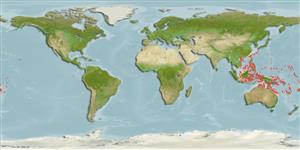>
Eupercaria/misc (Various families in series Eupercaria) >
Scaridae (Parrotfishes) > Scarinae
Etymology: Scarus: Greek, skaros = a fish described by anciente writers as a parrot fish; 1601 (Ref. 45335).
More on author: Bleeker.
Environment: milieu / climate zone / depth range / distribution range
экология
морской; солоноватоводный ассоциированный с рифами; пределы глубины 1 - 25 m (Ref. 90102). Tropical; 30°N - 24°S, 107°E - 170°W
Western Pacific: Indonesia to Samoa, north to the Ryukyu Islands, south to the Great Barrier Reef. Replaced by Scarus scaber in the Indian Ocean (Ref. 37816).
Size / Вес / Возраст
Maturity: Lm ? range ? - ? cm
Max length : 40.0 cm TL самец/пол неопределен; (Ref. 48636)
колючие лучи спинного плавника (общее число): 9; членистые (мягкие) лучи спинного плавника (общее число): 10; колючие лучи анального плавника 3; членистые (мягкие) лучи анального плавника: 9. Males recognized by the blue snout and band behind eye. Eastern form has blue cheek and western form has yellow cheek. Females grey to yellow with dusky saddle over back (Ref. 48636). Closely resembles S. oviceps and S. scaber. In S. oviceps, the initial phase has fewer, less vertical diagonal dark bars on the back and the terminal phase lacks the light-centered bar between the eye and the pectoral fin base, is darker and less brilliant blue on the upper head and back, and is usually larger.
Inhabits coral-rich areas of clear, protected reefs (Ref. 9710). Found in lagoon and seaward reefs (Ref. 90102). Feeds mainly on algae (Ref. 26993).
Life cycle and mating behavior
половая зрелость | размножение | нерест | икра | Fecundity | личинки
Oviparous, distinct pairing during breeding (Ref. 205).
Parenti, P. and J.E. Randall, 2000. An annotated checklist of the species of the labroid fish families Labridae and Scaridae. Ichthyol. Bull. J.L.B. Smith Inst. Ichthyol. (68):1-97. (Ref. 35918)
Статус Красного Списка МСОП (Ref. 130435)
Угроза для людей
Harmless
Использование человеком
рыболовство: коммерческий; аквариум: коммерческий
дополнительная информация
ссылкиаквакультура (рыбоводство)особенности рыбоводствастепень растяжениягенетикаElectrophoresesнаследуемостьболезниобработкаNutrientsMass conversion
соавторыизображенияStamps, Coins Misc.звукиCiguateraскоростьтип плаванияжаберная областьOtolithsмозгзрение
инструменты
Специальные отчеты
Скачать в формате XML
ресурсы в Интернет
Estimates based on models
Preferred temperature (Ref.
123201): 25.2 - 29.3, mean 28.5 °C (based on 1649 cells).
Phylogenetic diversity index (Ref.
82804): PD
50 = 0.5000 [Uniqueness, from 0.5 = low to 2.0 = high].
Bayesian length-weight: a=0.01380 (0.00789 - 0.02416), b=3.13 (2.97 - 3.29), in cm total length, based on LWR estimates for this species & Genus-body shape (Ref.
93245).
Trophic level (Ref.
69278): 2.0 ±0.00 se; based on food items.
устойчивость к внешним воздействиям (Ref.
120179): высокий, минимальное время удвоения популяции до 15 месяцев (Preliminary K or Fecundity.).
Fishing Vulnerability (Ref.
59153): Low to moderate vulnerability (30 of 100).
Nutrients (Ref.
124155): Calcium = 45.6 [23.8, 73.3] mg/100g; Iron = 0.696 [0.433, 1.175] mg/100g; Protein = 18.3 [16.3, 20.2] %; Omega3 = 0.06 [0.04, 0.10] g/100g; Selenium = 19.9 [9.9, 35.8] μg/100g; VitaminA = 44.9 [12.2, 162.7] μg/100g; Zinc = 2.69 [1.84, 3.65] mg/100g (wet weight);
